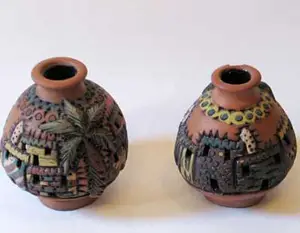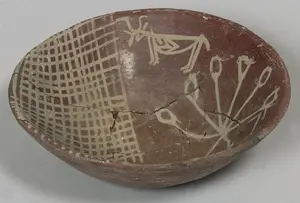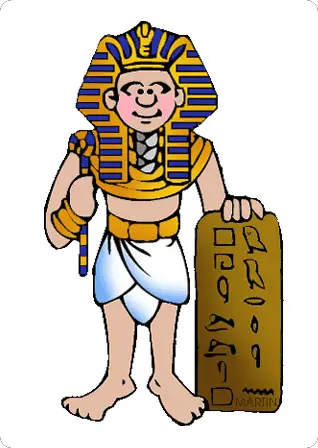Egyptian Pottery
Egyptian pottery was an important aspect of ancient Egyptian culture and art. The pottery was made using a variety of techniques, including wheel throwing and hand building. The designs on the pottery often depicted scenes from everyday life, as well as religious and mythological themes.
Egyptian pottery was also used for practical purposes, such as storing food and water. Many examples of Egyptian pottery have survived to the present day, providing valuable insights into the lives and beliefs of ancient Egyptians.
The Egyptians were one of the first cultures in the world to create pottery. They developed an excellent farming-based civilization and it is thought that they made pottery as a way to store grains and food items. They also needed pottery to hold water as well as for cooking food. Since Egyptians took a lot of pride in their art, they used pottery to reflect their creativity and imagination.

Egyptian Pottery Facts for Kids
- Pottery was used daily in ancient Egypt for storing food.
- They made pottery from Nile river clay.
- Egyptians often painted pottery with scenes from life.
- The pottery wheel was invented in Egypt around 4000 BCE.
- Jars were sealed with clay stoppers.
- Ancient Egyptians made beer and bread in pottery.
- Pots were often buried with people as grave goods.
- Different pottery styles were used in different eras.
- Thin pottery called “faience” was made for decoration.
- Pottery was also used for writing and keeping records.
Nile River
The Nile River was fundamental to ancient Egyptian pottery. Each year, its floods deposited clay, which was used as the primary material for pottery. This Nile clay, with high silicon and iron oxide content, would dry to a distinct brown or red color. It was essential for Egyptian potters, to define the appearance and purpose of their pottery. Thus, the Nile played a significant role in shaping Egypt’s unique pottery tradition.
Egyptian Pottery History
Ancient Egyptian pottery has a history that spans over 3,000 years, reflecting the progress of a remarkable civilization. Dating back to 4,000 B.C.E., the early pottery involved simple hand-building techniques. The introduction of the pottery wheel around 2600-2500 B.C.E. revolutionized production, leading to mass manufacturing. This evolution showcases the civilization’s artistic and technological advancement.
Ceramic Art
Ancient Egyptian pottery plays a significant role in ceramic art history. The Egyptians were early pottery innovators, crafting practical items and artwork. Techniques included hand-building, wheel-throwing, and the creation of a self-glazing pottery style known as faience. Decorations featured detailed relief carving and enameling. This rich legacy continues to shape modern ceramic art.
Pottery Manufacturing Process
The pottery manufacturing process in ancient Egypt was a carefully honed craft. It started with clay collection, followed by shaping using hand-building techniques or a pottery wheel introduced in the Old Kingdom. Once formed, the pieces were dried and decorated. Finally, they were fired in kilns, a process that hardened the clay. This process demonstrates the advanced craftsmanship and innovation of ancient Egypt.
Egyptian Faience
Egyptian faience, a self-glazing pottery type known for its vibrant turquoise or cobalt blue color, is a prominent aspect of ancient Egyptian pottery. Made from ground quartz or sand, faience was used in jewelry, amulets, and figurines. It was esteemed for its symbolism of life and rebirth, adding to its cultural significance.
Nile Clay and Marl Clay
Nile and Marl clay were crucial in ancient Egyptian pottery. Nile clay, abundant along the river, resulted in brown and red pottery. Marl clay, found in the desert and Nile region, led to yellow or white pottery. The different clay types influenced the variety of pottery forms and styles, showcasing the ingenuity of ancient Egyptian potters.
Pottery Wheel
The pottery wheel, introduced in Egypt’s Old Kingdom around 2600-2500 B.C.E., revolutionized ancient Egyptian pottery. It enabled faster production and more uniform pottery vessels, allowing for mass production and more complex designs. This marked a significant shift in pottery techniques, enhancing the aesthetic appeal and variety of Egyptian pottery.
Pottery Decoration
Ancient Egyptian pottery decoration reflects a blend of artistry and functionality, highlighting the importance of pottery in daily life and cultural expression. These ceramic vessels, adorned with designs and embellishments, served practical purposes and showcased artistic talent.
Egyptian potters used techniques like painting, carving, and glazing, often incorporating religious symbols or scenes from daily life. These decorated clay works provide insight into the techniques, symbolism, and aesthetics of ancient Egypt.
Kiln Technology
Kiln technology greatly influenced ancient Egyptian pottery. Early potters used primitive pit kilns, but technology improved over time, enabling higher firing temperatures and large-scale production. This advancement led to varied pottery types like the renowned Egyptian faience, reflecting the civilization’s technological progress and potters’ craftsmanship.
Functional and Religious Pottery
Ancient Egyptian pottery was not only functional but also held religious significance. On one hand, functional pottery was made to store food or liquids and assist in daily tasks, mirroring ancient Greek pottery styles. On the other hand, religious pottery showcased the deep connection between art and belief in ancient Egypt.
The fertility god, Khnum, was often referred to as the “Divine Potter,” forming a strong link between the everyday work of potters and the divine. Religious pottery often took the form of vessels for oils and fragrant liquids used in ceremonies, clay figures representing Egyptian gods, or items meant for burial with the deceased.
These dual aspects of function and faith highlighted the integral role pottery played in the daily and spiritual lives of ancient Egyptians.
Vienna System
The Vienna System, developed by Austrian scientists, is vital for classifying ancient Egyptian pottery. It identifies types based on the clay used and other components in the pottery fabric. With ten classifications, it helps archaeologists date pottery pieces and gain insight into ancient Egyptian pottery techniques and innovations.

From Clay to Craftsmanship: Unveiling Egyptian Pottery’s Secrets
Egyptian pottery, made from abundant Nile river clay, featured simple designs. Potters initially used coiled clay strands and sun-drying techniques, later incorporating slow-turning pottery wheels for varied shapes and sizes. Egyptians often colored their pottery, scratching designs into the surface and using smoke exposure for dark black appearances.
Evolution of Egyptian Pottery: From Simplicity to Symbolism
Early pre-dynasty period (before the pharaohs), pottery was fairly simple, but useful for their needs. They experimented with different designs and some have been discovered in the shape of the heads of their gods.

Pottery became such a popular need in ancient Egyptian life that they had people that specialized in creating large quantities of pottery. They made items for daily use and special pottery designs were made to be included in the tombs of those that had passed away. By 3500 BC, the artists that made pottery began to add images that showed animals and activities that they were involved in. They included boats, people, and all of the animals that they saw every day.
Craftsmanship and Colors: Egyptian Pottery’s Artistic Evolution
Egyptians evolved their pottery techniques, creating various shapes and sizes, sometimes featuring double tops, human-shaped feet, or clay decorations like ibexes and flamingos. They used red ocre, a natural iron oxide pigment, as a coloring for pottery; sometimes covering the entirety, other times just for decoration. Crushed minerals were combined for diverse artistic effects.
From Porous to Perfection: Egyptian Pottery’s Glazed Transformation
Egyptians found that without any kind of glaze, their pottery was ‘porous’ and allowed liquids to seep out as well as not being able to seal food well. They developed a number of glaze methods and began using ‘firing’ techniques in high-temperature ovens.
The glazes also brought out more of the colors that they used. During what is known as the ‘New Kingdom’ era, they decorated their pottery after they fired it and their favorite colors were blue (called Egyptian blue), red (made with red ochre), and black (made with carbon or a combination of oxide/manganese minerals)
Egyptian pottery of high design and quality was often created for the pharaoh and his court. The poor and working class used pottery for children’s toys including dolls, toy ships and even board games with clay pieces. Because the poor could not afford the expensive burials, pottery was sometimes used as burial coffins.
What was the primary source of clay for Egyptian potters?
Egyptian potters primarily sourced their clay from the Nile River and its surrounding areas. The clay was often mixed with other materials such as sand or straw to create a more durable and workable material for pottery making.
What are the two main types of ancient Egyptian pottery?
The two main types of ancient Egyptian pottery are red and black pottery. Red pottery was made from a mixture of clay and Nile silt, while black pottery was made from a mixture of clay and organic matter. Both types were used for a variety of purposes, including storage, cooking, and funerary offerings.
What are the different techniques used to decorate ancient Egyptian pottery?
Ancient Egyptians used various techniques to decorate their pottery, including painting, incising, and carving. They often used natural pigments and dyes to create intricate designs and patterns, and some pottery was even adorned with precious metals and stones. These decorative techniques not only served a functional purpose, but also reflected the cultural and religious beliefs of the ancient Egyptian civilization.
What are some of the most common motifs found on ancient Egyptian pottery?
Ancient Egyptian pottery often featured motifs such as lotus flowers, animals like lions and birds, and hieroglyphics. These designs were not only decorative but also held symbolic meaning, representing concepts such as fertility, power, and the afterlife.
What were some of the different uses of ancient Egyptian pottery?
Ancient Egyptian pottery was used for a variety of purposes, including storing food and water, cooking, and serving. It was also used for religious and funerary purposes, such as holding offerings and as burial vessels. Some pottery was decorated with intricate designs and hieroglyphics, serving as a form of art and communication.
How was ancient Egyptian pottery fired?
Ancient Egyptian pottery was fired using a kiln, which was essentially a large oven made of mud bricks. The kiln was heated using wood or dried dung, and the pottery was placed inside and fired at high temperatures to harden and strengthen it.
What are some of the most famous examples of ancient Egyptian pottery?
Some of the most famous examples of ancient Egyptian pottery include the Naqada I and II periods, the Gerzean period, and the New Kingdom period. These pottery pieces were often decorated with intricate designs and symbols, and were used for both practical and ceremonial purposes.
Where can I find ancient Egyptian pottery today?
One can find ancient Egyptian pottery in various museums and archaeological sites around the world, including the British Museum in London, the Louvre in Paris, and the Egyptian Museum in Cairo. Online auction sites and antique dealers may also offer authentic pieces for sale, but caution should be exercised to ensure their legitimacy.



